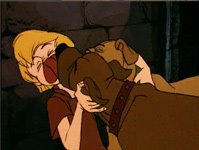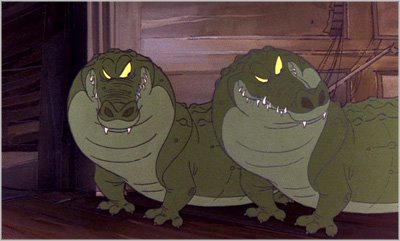Disney Cloning
Thanks to the internet, I can read Russian. Sort of.
A few cut and pastes later, and even the densest wedges of foreign language text can be turned into gist-adhering pigeon English. Here's some of what an intriguing Russian article taught me about Disney's animation recycling practices (thanks to Atomic Hyperbole for the link).
It is said quite sufficiently about the labor expense, the high costs and the complexity of the animation (in particular about Disney animations). Even for professional animator several seconds of the life of only one character can require the week of tedious work! It is not surprising that full-length, this is the luxury, which they can itself allow only large studios with the large association of artists and the decent financing.
For creating the first full-length tape Walt Disney, it was required the order of three years, more than 500 artists (some animators it was three ten) and one-and-a-half million dollars! According to the most modest estimations today this money makes the equivalents of approximately $40 of million; however, one should consider that Walt Disney, as a rule, paid to his artists extremely little, but processing he did not pay generally.
Is it possible to simplify task? Certainly, it is possible! For this there are many methods. It is possible to decrease the number of characters simultaneously being present in the sequence, to use the pieces animation (to change the part of the character, without changing rest) or to weaken stringent requirements on its quality. Finally, essence itself about Disney animation and other classical manners of classic animation imply the possibility to facilitate task, to reduce labor expenses and to get rid of the most routine work. This discussion deals in particular with the repeated use of previously created material.
It is no secret that at the basis of the classical manners of animation lies upon the principle of the separation of sequences into the layers (be it the layers of celluoloid or virtual layers in the computer memory), manipulations with each of which can be produced independently. And, nevertheless, one ought not to consider that regarding Disney, the animations there are no examples of cloning. The cloning are located also in a big enough quantity, although, it goes without saying, they are not advertised. Even the inexperienced spectator can note some. Others immediately will not be noted by professionals, so they are ingenious!
With the preparation of this material I obtained great pleasure, finding the examples published, and to assume that the acquaintance with them of the readers of my site will be not less entertaining. I will reserve the right not to discuss the ethical side of a question. Cloning vs. Disney, the animations adapted, and it is necessary it will be subdued with this fact.
Okay, so as I said, you can just about get the gist of the idea from the text - that Disney animators recycled animation, though in a very subtle fashion, and often rather artfully. The pictures speak volumes, however. Here are a few.
UPDATE: You must see this video of examples.








No comments:
Post a Comment